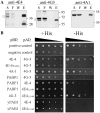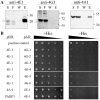A novel 4E-interacting protein in Leishmania is involved in stage-specific translation pathways
- PMID: 21764780
- PMCID: PMC3201875
- DOI: 10.1093/nar/gkr555
A novel 4E-interacting protein in Leishmania is involved in stage-specific translation pathways
Abstract
In eukaryotes, exposure to stress conditions causes a shift from cap-dependent to cap-independent translation. In trypanosomatids, environmental switches are the driving force of a developmental program of gene expression, but it is yet unclear how their translation machinery copes with their constantly changing environment. Trypanosomatids have a unique cap structure (cap-4) and encode four highly diverged paralogs of the cap-binding protein, eIF4E; none were found to genetically complement a yeast mutant failing to express eIF4E. Here we show that in promastigotes, a typical cap-binding complex is anchored through LeishIF4E-4, which associates with components of the cap-binding pre-initiation complex. In axenic amastigotes, expression of LeishIF4E-4 decreases and the protein does not bind the cap, whereas LeishIF4E-1 maintains its expression level and associates with the cap structure and with translation initiation factors. However, LeishIF4E-1 does not interact with eIF4G-like proteins in both life stages, excluding its involvement in cap-dependent translation. Using pull-down assays and mass-spectrometry, we identified a novel, non-conserved 4E-Interacting Protein (Leish4E-IP), which binds to LeishIF4E-1 in promastigotes, but not in amastigotes. Yeast two-hybrid and NMR spectroscopy confirmed the specificity of this interaction. We propose that Leish4E-IP is a translation regulator that is involved in switching between cap-dependent and alternative translation pathways.
Figures





Similar articles
-
A newly identified Leishmania IF4E-interacting protein, Leish4E-IP2, modulates the activity of cap-binding protein paralogs.Nucleic Acids Res. 2020 May 7;48(8):4405-4417. doi: 10.1093/nar/gkaa173. Nucleic Acids Res. 2020. PMID: 32232353 Free PMC article.
-
Nutritional stress affects an atypical cap-binding protein in Leishmania.RNA Biol. 2012 Dec;9(12):1450-60. doi: 10.4161/rna.22709. Epub 2012 Nov 7. RNA Biol. 2012. PMID: 23135001
-
Binding specificities and potential roles of isoforms of eukaryotic initiation factor 4E in Leishmania.Eukaryot Cell. 2006 Dec;5(12):1969-79. doi: 10.1128/EC.00230-06. Epub 2006 Oct 13. Eukaryot Cell. 2006. PMID: 17041189 Free PMC article.
-
eIF4E and Interactors from Unicellular Eukaryotes.Int J Mol Sci. 2020 Mar 21;21(6):2170. doi: 10.3390/ijms21062170. Int J Mol Sci. 2020. PMID: 32245232 Free PMC article. Review.
-
Taking a re-look at cap-binding signatures of the mRNA cap-binding protein eIF4E orthologues in trypanosomatids.Mol Cell Biochem. 2021 Feb;476(2):1037-1049. doi: 10.1007/s11010-020-03970-w. Epub 2020 Nov 10. Mol Cell Biochem. 2021. PMID: 33169189 Review.
Cited by
-
Regulation of Translation in the Protozoan Parasite Leishmania.Int J Mol Sci. 2020 Apr 23;21(8):2981. doi: 10.3390/ijms21082981. Int J Mol Sci. 2020. PMID: 32340274 Free PMC article. Review.
-
eIF4F-like complexes formed by cap-binding homolog TbEIF4E5 with TbEIF4G1 or TbEIF4G2 are implicated in post-transcriptional regulation in Trypanosoma brucei.RNA. 2014 Aug;20(8):1272-86. doi: 10.1261/rna.045534.114. Epub 2014 Jun 24. RNA. 2014. PMID: 24962368 Free PMC article.
-
Trypanosoma brucei translation initiation factor homolog EIF4E6 forms a tripartite cytosolic complex with EIF4G5 and a capping enzyme homolog.Eukaryot Cell. 2014 Jul;13(7):896-908. doi: 10.1128/EC.00071-14. Epub 2014 May 16. Eukaryot Cell. 2014. PMID: 24839125 Free PMC article.
-
Trypanosoma cruzi eIF4E3- and eIF4E4-containing complexes bind different mRNAs and may sequester inactive mRNAs during nutritional stress.Nucleic Acids Res. 2025 Jan 11;53(2):gkae1181. doi: 10.1093/nar/gkae1181. Nucleic Acids Res. 2025. PMID: 39658061 Free PMC article.
-
Phosphorylation and interactions associated with the control of the Leishmania Poly-A Binding Protein 1 (PABP1) function during translation initiation.RNA Biol. 2018;15(6):739-755. doi: 10.1080/15476286.2018.1445958. Epub 2018 Mar 23. RNA Biol. 2018. PMID: 29569995 Free PMC article.
References
-
- Fletcher CM, McGuire AM, Gingras AC, Li H, Matsuo H, Sonenberg N, Wagner G. 4E binding proteins inhibit the translation factor eIF4E without folded structure. Biochemistry. 1998;37:9–15. - PubMed
Publication types
MeSH terms
Substances
Grants and funding
LinkOut - more resources
Full Text Sources
Molecular Biology Databases
Miscellaneous

